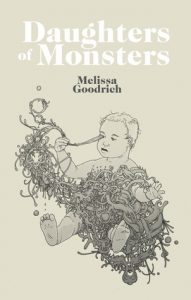
‘You’re a monster. A surveyor of night. A reptilian majesty. An everlasting. Snail-eyed, scaled, iridescent, and barbed.’
–Daughters of Monsters
The quaint collection of seventeen fable-like tales that is ‘Daughters of Monsters’ is, to read, a surreal and unpresuming experience. Melissa Goodrich creates an absurd sensation somewhere in between insecurity and open-mindedness where it is almost impossible to predict anything at all about the upcoming plot; similarly it can be interestingly difficult to fully comprehend the pages you have already read.
Being numerous lengths, the stories go into various levels of detail – meaning there are one or two tales that reveal so little that they challenge your imagination and creativity to the extent where you have practically no idea what on earth you’re reading. Although it can be refreshing to have to dust off your deer-stalker and do some Sherlock Holmes deduction, the shorter stories didn’t particularly interest me. They come across as respites to the more compelling longer tales, but unfortunately I am one of those who skip the two-minute interlude on an album and here the shortest features of the collection created an impatience to proceed to the next narrative.
Having said that, the stories that were good were good. Introducing the collection is ‘She Wants, She Gets’, a manipulated telling of ‘Cinderella’ where the poor girl serves as a borderline slave to her malicious step-mother and -sisters. We all know the original tale, but Goodrich adds an unusual quirk by remodelling Cinderella as a fire, a piece of paper, a bird, until we lose confidence about the literal legitimacy of the narrator.
This fantastic weirdness of surrealism rolls into more than half of the stories, making you begin each one with increasing doubt of who/what the narrator is, and equally who/what they will become in the limited pages they have to tell their tale. An example of this is ‘Birthday People’, an odd account of a birthday celebration where the attendees are multiples of the same man at several stages in his life – named Breakup Ben, Stache and Little Benny – and he is given the opportunity to communicate with and learn himself. In a strange sense, I found this story pretty: there’s a curious charm to be experienced in reading someone care for their younger selves in an almost fatherly fashion.
The story that stood out the most for me was ‘Where Dust Storms May Exist’, which I interpreted as a bizarrely beautiful yet shocking stand against the meat industry. The narrator is a worker at a slaughterhouse where the livestock is unconventional: they farm angels. Yep. Angels. But not the rosy-cheeked cherub you’re picturing – these angels are ‘stringy-thin’ prepubescent boys with two heads and eyes ‘like rock’. The story follows this worker through his growing moral distress surrounding his occupation, with grotesque accounts of the ‘tucked away’ happenings opening your eyes as the reader to your own desensitivity to this kind of treatment when it is an animal and not a child experiencing it. By oozing power and tragically unlocking complex social issues, I would say this story is the essence of Melissa Goodrich’s writing. Whilst it carries the same elements of obscurity as other works in the collection, the idea of the angels is used knowingly and pulls at your conscience just enough for you to begin comprehending the issues surrounding farming and agriculture.
The title story ‘Daughters of Monsters’ is, in contrast to the majority of the tales, quite a personal and witty account. Bluntness is added to the whimsical cocktail of emotion that is Goodrich’s style, and following the narrator’s brute honesty through her romantic ups and downs seems to include the reader rather than making them work for understanding. We follow the narrator through her experiences with an array of mysterious family members – a monster father who cooks up ‘hair stew’, a part-bird mother who lays eggs ‘all over the place’, a buzzard boyfriend who has an affair with her transparent younger sister.
Although the surrealist element is carried through to this story I found that in some ways it didn’t matter that the metaphorical meaning behind the ‘monster’ figure was unclear. At this point in the collection (story number fourteen) the witty and sometimes almost satirical telling alone gives the story its allure.
As a whole, I can only describe the book as the Tim Burton of short story collections – I don’t really understand everything, I can see their relevance to each other as a compilation as well as each tale’s individual cleverness, but most importantly I like it. The chaos of occasionally nonsensical yet raw stories succeeded at intriguing me and forcing me to search for hidden meanings and representations, with images and ideas that will no doubt keep me occupied from time to time.
Some of the coverage you find on Cultured Vultures contains affiliate links, which provide us with small commissions based on purchases made from visiting our site. We cover gaming news, movie reviews, wrestling and much more.



